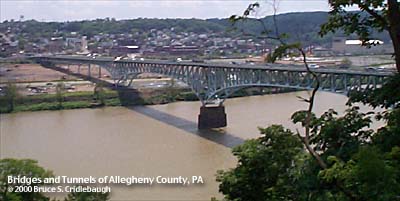| Home > All By Location regional map > Pittsbugh East > Homestead High Level Bridge | |||
|
|

View southwest from Brown's Hill Elevation drawing looking downstream, channel spans only Elevation drawing looking downstream, full length 
Postcard More detail photos OFFICIAL NAME: Homestead Grays Bridge Homestead High Level Bridge OTHER DESIGNATION: pghe591-17 LOCATION: Homestead - Pittsburgh USGS 7.5" Topo Quad - UTM Coordinates: Pittsburgh East - Zone 17; 0591 4473 CARRIES: motor vehicles, 4 lanes sidewalk on each side BETWEEN: -- Browns Hill Road on right descending bank of Monongahela River -- West Eighth Av, with ramps at West Fifth Av, on left descending bank of Monongahela River CROSSES: -- (RDB to LDB) CSX RR [B&O RR], route of Second Av [Braddock Plank Rd]; Monongahela River at mile 7.3; Waterfront Dr; CSX RR [P&LE RR]; NS RR [Conrail]; 7th Av TYPE OF CONSTRUCTION / DESIGN: Steel cantilever spandrel-braced deck arch (Wichert truss) LENGTH OF MAIN SPAN: 516.3 ft TOTAL LENGTH (including longest elevated ramp): HEIGHT OF DECK: 109.3 ft, vertical clearance, at center line of channel span Emsworth Dam normal pool level 710 ft YEAR ERECTED / ENGINEER: 1936 ADDITIONAL INFO: Excavation began in 1935 for the new High Level Bridge to eventually replace the old Brown's Bridge [Homestead and Highland Bridge]. The new bridge, constructed at a cost of $2,800,000.00, was dedicated in 1937. In 1941, "United States Steel Homestead Works, under the direction of United States Government's Defense Plant Corporation, expanded thereby causing the demolition of 1,225 buildings in lower Homestead. Over 3,500 people were to be relocated. The new plant expanded with 11 steel furnaces, a 45 inch slab mill, 160 inch plate mill, a forging, heating and machine shop. Homestead now was capable of producing armor plate for useby the Navy on it's battleships and cruisers." The Homestead High Level Bridge was the first use of the unusual "Wichert Self-Adjusting Truss". The Wichert Truss is a cantilever spandrel-braced deck arch which is not a "true arch" bridge. The curved lower chord gives the bridge the form of an arch, but it does not rely on arch action to carry the load. The open diamond panel above each pier is the easily recogized mark of this truss type; without a vertical truss member in this hinged location. Before the use of computers, the interaction of forces on spans which crossed multiple supports was difficult to calculate. One solution to the problem was developed by E. M. Wichert of Pittsburgh, PA, in 1930. By introducing a open, hinged quadrilateral over the intermediate piers, each span could be calculated independently. Another Wichert Truss is the Charles Anderson Bridge carrying the Boulevard of the Allies over Junction Hollow in Oakland. July 12, 2002, the bridge was renamed the Homestead Grays Bridge in honor of the Negro League baseball team. The team began as a group of steelworkers in 1912. As they were banned from playing in the Major Leagues, the Negro Leagues (National and American) were formed in the 1920s and continued into the 1950s. The Grays and the Pittsburgh Crawfords were the city's Negro National League teams. The Grays dominated the league from the start with 10 pennants and 3 World Series. The league disbanded soon after Jackie Robinson became the first player to break the color barrier when he joined the Brooklyn Dodgers in 1947. FIELD CHECKED: 10-May-2000 INFO SOURCES: USACE Monongahela River Nav. Charts; "HOMESTEAD CENTENNIAL CELEBRATION GUIDEBOOK - 100 YEARS - 1890 to 1980" (Aug. 27 to Sept. 1 1980 Celebration Event) Submit info or inquiry - share some facts or ask a question. Introduction -- Nearby Structures Page created: Last modified: 11-Jul-2002 |
View Larger Map 
| |
| copyright: © Bruce S. Cridlebaugh 1999-2008 All Rights Reserved | |||